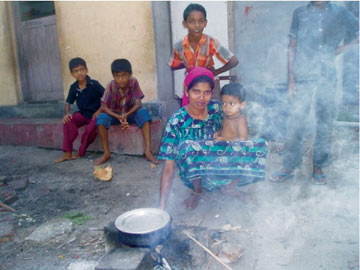|
NEWS NOTES
Cow manure adds to arsenic epidemic
 William Rudolph |
| New research suggests that cow dung used by millions of people in India in cooking fires may be adding to the arsenic poisoning epidemic. |
Arsenic is poisoning millions of people in the state of West Bengal in India. Tube well water — a popular source of drinking water in the region — is often laced with toxic concentrations of the metal, which occurs naturally in the region. Because the contaminated water is used for irrigation, arsenic also makes its way into agricultural produce, including rice, a staple food in the region, and rice straw, which feeds cattle. Now scientists have discovered that arsenic also lingers in the air — a result of burning cow dung cakes as a fuel in unventilated ovens for cooking.
People living in West Bengal routinely use dried cow dung patties as an alternative to coal, kerosene or liquefied petroleum gas because of the dung’s low price and easy availability. This led Dipankar Chakraborti of Jadavpur University in Kolkata, India, and his team to include samples of cow dung cakes in a study of the sources of arsenic poisoning in which they also considered water, soil, straw and cow urine from two arsenic-affected districts in West Bengal. They also obtained air samples from kitchens while villagers were cooking in cow-dung-cake-fired ovens. Chakraborti and his team found significant concentrations of arsenic in all samples they collected, including the indoor air. Inhalation of arsenic can cause respiratory problems, such as persistent coughing, chronic bronchitis and X-ray abnormalities, the researchers wrote in the October Journal of Environmental Monitoring.
Arsenic is naturally present throughout Earth’s crust, especially in the Himalayas, and can, at high enough levels, cause skin cancer and other health problems. In the Ganga-Meghna-Brahmaputra delta plain — an area covering 569,749 square kilometers of India and Bangladesh with a population of more than 500 million — an epidemic of arsenic poisoning from contaminated groundwater has been under way for more than a decade. The fact that people are not only exposed to arsenic through ingestion of water and food but also inhalation adds to the danger, the researchers wrote.
“This is a very interesting study that illustrates the need to be creative to try to find all the potential exposure pathways,” says Geoff Plumlee, a geologist with the U.S. Geological Survey in Denver, Colo. “Once you think about the fact that arsenic is in straw and water consumed by cattle, it makes a lot of sense that the burning of cow dung is something that needs to be looked at.”
The authors also point out that arsenic from combustion could accumulate in food and water, potentially concentrating an additional source of arsenic not accounted for by inhalation alone. This is an important factor to consider, Plumlee says, adding that work in China has shown that consumption of chili peppers and corn dried over hearths burning arsenic-rich coal is a very important exposure pathway. “Arsenic is liberated during the coal combustion and ends up depositing on the chili peppers and corn, which are then consumed.”
Plumlee adds that more detailed studies are needed to find out how arsenic is transformed through cow dung combustion and what form it assumes once it is released into the air. “The form of the arsenic strongly affects toxicity,” he says. For example, organic arsenic compounds are generally considered less toxic than inorganic arsenic compounds. The form determines how the body takes up the arsenic, for example, whether the lungs readily absorb it after inhalation or whether it gets trapped in the mucus and swallowed, Plumlee says. “This innovative study certainly raises intriguing questions about a previously understudied potential exposure pathway for arsenic,” he says.

 Subscribe
Subscribe


